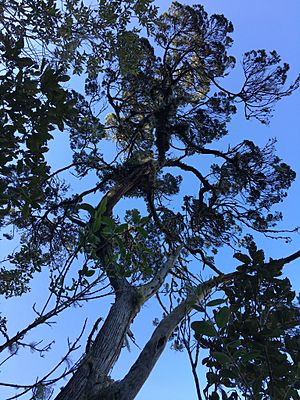Juniperus comitana facts for kids
Quick facts for kids Juniperus comitana |
|
|---|---|
 |
|
| Conservation status | |
| Scientific classification | |
| Genus: |
Juniperus
|
| Species: |
comitana
|
The Juniperus comitana is a special type of tree called a conifer. Conifers are trees that usually have needles or scales instead of broad leaves. They also produce cones instead of flowers. This particular tree belongs to the Cupressaceae family, which includes many well-known trees like cypresses and junipers.
You can find the Juniperus comitana growing in parts of Guatemala and Mexico. It was first described as a species in 1944 by a scientist named Maximino Martínez.
Contents
About the Juniperus comitana
The Juniperus comitana is a type of juniper tree. Junipers are known for their strong, woody stems and often have a distinct smell. They are evergreen, meaning their leaves stay green all year round.
Where it Lives
This juniper tree grows in specific areas of Guatemala and Mexico. It prefers certain environments to thrive. These trees are an important part of the natural forests in these regions.
Why it's Endangered
Sadly, the Juniperus comitana is currently listed as an endangered species. This means there are not many of these trees left in the wild. The International Union for Conservation of Nature (IUCN) keeps track of plants and animals that are at risk. They use a system called IUCN3.1 to show how endangered a species is. For the Juniperus comitana, "EN" stands for "Endangered."
There are many reasons why a species might become endangered. It could be because their habitat (the place where they live) is being destroyed. This can happen due to things like deforestation (cutting down too many trees) or changes in land use. Climate change can also affect where plants can grow.
Protecting this Tree
Because the Juniperus comitana is endangered, it's important to protect it. Conservation efforts help to save these unique trees and their habitats. This can involve setting up protected areas, planting new trees, and educating people about the importance of biodiversity.
See also
In Spanish: Cedro para niños


